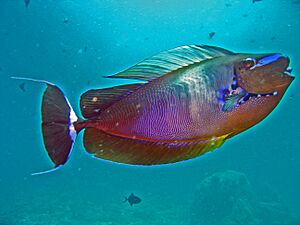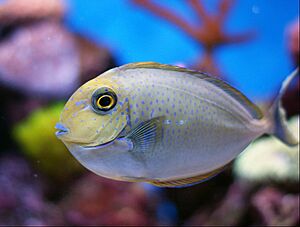Bignose unicornfish facts for kids
Quick facts for kids Bignose unicornfish |
|
|---|---|
 |
|
| Adult in the Maldives | |
| Conservation status | |
| Scientific classification | |
| Synonyms | |
|
The bignose unicornfish (Naso vlamingii) is a cool marine fish. It's also known as the scribbled unicornfish or Vlaming's unicornfish. This fish belongs to the Acanthuridae family. This family includes surgeonfishes and tangs. You can find this species in the warm waters of the Indo-Pacific Ocean.
Contents
What's in a Name? The Bignose Unicornfish's Story
The bignose unicornfish was first officially described in 1835. It was named by a French zoologist named Achille Valenciennes. He called it Naseus vlamingii at first. This fish is part of a group called Naso. This group is the only one in its special fish family.
Why is it Called Naso vlamingii?
The name Naso vlamingii honors a Dutch explorer. His name was Cornelis de Vlamingh. He collected fish and drew pictures of them for a museum. The scientist who named the fish used one of Vlamingh's drawings. That's how this fish got its special name!
What Does the Bignose Unicornfish Look Like?
The bignose unicornfish has a tall dorsal fin on its back. This fin has 6 spines and 26 or 27 soft rays. It also has an anal fin on its belly. This fin has 2 spines and between 27 and 29 soft rays.
Its Unique "Horn" and Body Shape
This fish has a body that is quite deep. A cool thing about this fish is the big, round bump on its head. It grows right above its nose! This bump makes it look like it has a "horn," which is why it's called a unicornfish. On each side of its tail base, there are two bony plates. These plates have sharp spines that point forward.
Amazing Tail and Colors
Adult bignose unicornfish have long, flowing parts on their tail fin. These look like long threads! Their main color is usually greyish-brown or reddish-brown. But here's a neat trick: they can change their color very quickly! They often have small dark blue spots on their head and upper body. These spots can join together to form stripes on their lower body.
There's also a wide blue band that goes from their eye to the front of their head bump. Their lips are blue, and they have a blue spot near their pectoral fin. The tail fin is blue at its base and grey in the middle. It has a yellow edge and blue outer edges on its long parts. When these fish are showing off or talking to cleaner fish, their blue markings can become super bright! The biggest bignose unicornfish ever found was about 60 centimeters (about 2 feet) long.
Where Do Bignose Unicornfish Live?
The bignose unicornfish lives in a huge area. This area stretches from the eastern coast of Africa, across the Indian Ocean, and into the Pacific Ocean. You can find them in places like southern Japan, the Galápogos Islands, and even off the coast of Australia. In Australia, they live near the Great Barrier Reef and other islands.
Their Favorite Hangouts
These fish like to live in deep lagoons and coral reefs that face the open ocean. They often swim together in groups. They like to eat tiny creatures called zooplankton. They usually feed around the higher parts of deep slopes and drop-offs in the ocean.
What Do Bignose Unicornfish Eat?
The bignose unicornfish is an omnivore. This means it eats both plants and animals. They have been seen swimming at night with other big fish, like barracudas and trevally. They sometimes eat small particles that these bigger fish leave behind.
Bignose Unicornfish and People
People sometimes catch bignose unicornfish for food in some areas. They are also sometimes caught for the aquarium trade. This means they can be kept as pets in home aquariums.



